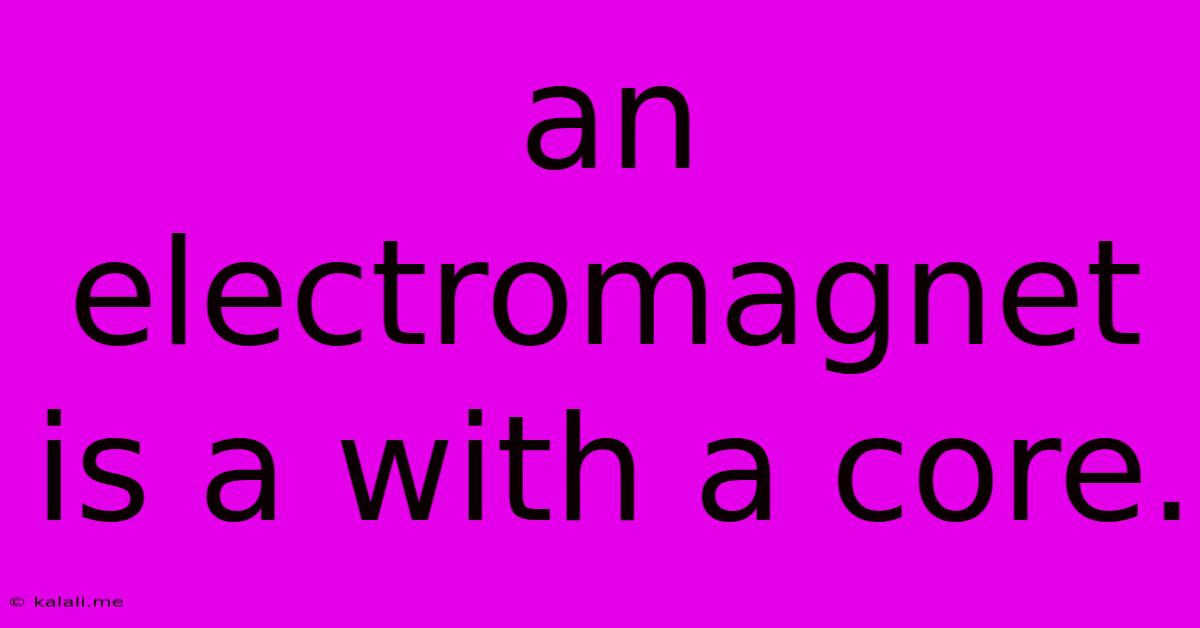An Electromagnet Is A With A Core.
Kalali
Jun 15, 2025 · 3 min read

Table of Contents
An Electromagnet is a Magnet with a Core: Understanding the Fundamentals
An electromagnet is a type of magnet whose magnetic field is produced by an electric current. Unlike permanent magnets, which retain their magnetism even without an electric current, electromagnets only exhibit magnetic properties when electricity flows through them. A crucial component of an electromagnet is its core, which significantly impacts its magnetic strength and overall performance. This article delves into the core's role, exploring different core materials and their effects on electromagnet functionality.
What Makes an Electromagnet Work?
At its simplest, an electromagnet consists of a coil of wire wrapped around a core material. When an electric current passes through the wire, it generates a magnetic field. This field aligns with the magnetic domains within the core material, significantly amplifying the overall magnetic strength. The core material plays a critical role in determining the electromagnet's effectiveness. The strength of the magnetic field is directly proportional to the number of turns in the coil and the current flowing through it. This relationship is described by Ampere's Law.
The Importance of the Core Material
The core material isn't just any piece of metal; its properties are crucial for optimizing electromagnet performance. Different core materials offer varying degrees of permeability, which determines how easily a material can be magnetized. High permeability materials allow for a stronger magnetic field with less current. Common core materials include:
- Iron: A readily available and inexpensive material, iron offers good permeability, making it suitable for many applications. However, it's susceptible to saturation, meaning its ability to increase magnetic field strength diminishes at high current levels.
- Steel: Various types of steel offer enhanced strength and durability compared to iron, and also exhibit good permeability. Different steel alloys can be chosen to tailor the electromagnet's properties for specific applications.
- Ferrite: A ceramic material composed of iron oxide and other metallic elements, ferrite offers high resistivity, reducing eddy current losses. Eddy currents are unwanted currents induced in the core material, which dissipate energy and reduce efficiency. This makes ferrite cores ideal for high-frequency applications.
- Laminated Iron: To minimize eddy current losses in iron cores, they are often laminated. This means the core is made of thin sheets of iron insulated from each other, thereby reducing the path for eddy currents.
- Air Core: While less common, an air core electromagnet doesn't use any ferromagnetic material. This results in a weaker magnetic field, but it is suitable for applications requiring high precision or where the influence of the core material is undesirable.
Choosing the Right Core Material: Factors to Consider
The selection of the core material is critical and depends on several factors including:
- Required magnetic field strength: High permeability materials like iron and steel are preferred for applications demanding strong magnetic fields.
- Frequency of operation: Ferrite cores are often preferred for high-frequency applications due to their high resistivity and low eddy current losses.
- Cost considerations: Iron is the most cost-effective option, while other materials like specialized steel alloys or certain ferrites may be more expensive.
- Size and weight constraints: The size and weight of the core material must be considered, especially in portable or space-constrained applications.
Applications of Electromagnets
Electromagnets are used extensively in various applications, ranging from simple devices to complex machinery. Examples include:
- Electric motors and generators: Electromagnets are fundamental components, generating the magnetic fields necessary for their operation.
- Speakers and headphones: Electromagnets convert electrical signals into sound waves.
- Magnetic levitation (Maglev) trains: Powerful electromagnets enable these trains to levitate above the track.
- Recycling and material handling: Electromagnets are used to lift and separate ferrous metals.
- Magnetic resonance imaging (MRI) machines: Strong electromagnets create powerful magnetic fields for medical imaging.
In conclusion, an electromagnet's core is an integral component that significantly influences its magnetic field strength, efficiency, and overall performance. The choice of core material depends heavily on the specific application and its requirements. Understanding the properties of different core materials is crucial for designing and optimizing electromagnets for various technological advancements.
Latest Posts
Latest Posts
-
Did Rabindranath Tagore Refused Nobel Prize
Jun 16, 2025
-
The Difference Between Inference And Observation
Jun 16, 2025
-
Amine Vs Amide Vs Imine Vs Imide
Jun 16, 2025
-
Which Idea Was Supported By Both Plato And Aristotle
Jun 16, 2025
-
Which Of The Following Is True Of Dcen
Jun 16, 2025
Related Post
Thank you for visiting our website which covers about An Electromagnet Is A With A Core. . We hope the information provided has been useful to you. Feel free to contact us if you have any questions or need further assistance. See you next time and don't miss to bookmark.